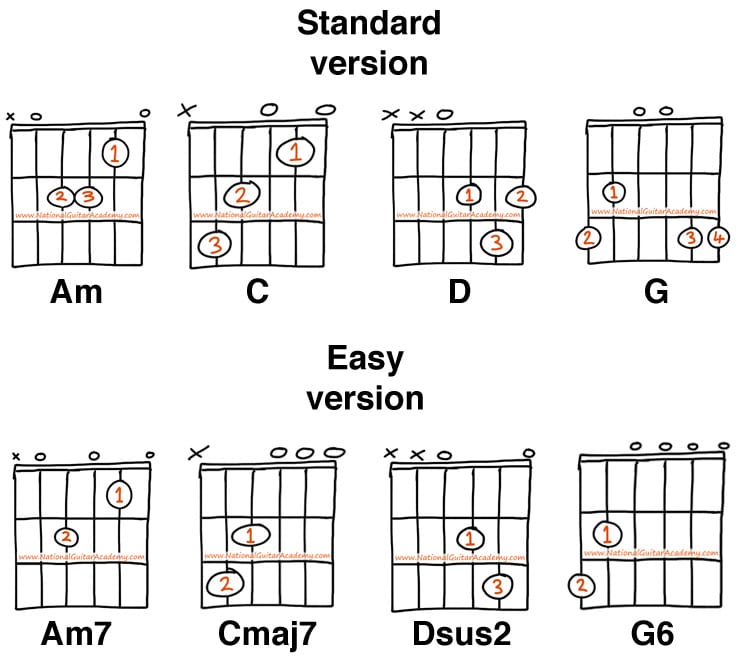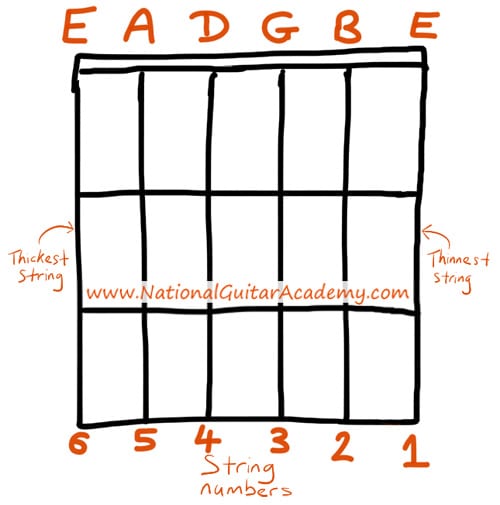Looking for classical guitar lessons? We’ve got you covered. This is a 4-step programme you can follow to start making music with your classical guitar today.
In this free guitar lesson you will learn:
- A 4-step roadmap for learning classical guitar
- How to learn chords at lightning speed
- How to play fingerstyle/arpeggio classical guitar
- The 2 most important scales every classical guitarist must know
The classical guitar is a beautiful instrument and in these 4 classical guitar lessons you’re going to discover high-value, super-practical tips that will move you forward as a classical guitarist. Let’s dive straight in..
Over 250,000 guitar-learners get our world-class guitar tips & tutorials sent straight to their inbox: Click here to join them
Building a solid foundation
Learning classical guitar is a bit more technical than learning ‘standard’ acoustic guitar or electric guitar. (And we’ll cover those more technical elements later in this guide.)
But the best place to start for ALL guitarists is with basic chords.
Lesson 1: How to learn basic chord shapes at lightning speed
Regardless of what type of guitar you choose to learn first, you should always start by learning chords.
- Of course it’s important to learn notes, but that will come in time.
- When you start learning guitar, start with chords.
Understand the different types of chords: ‘open’ vs ‘barred’
The most important thing when learning guitar is momentum. We want you to enjoy playing and look forward to your practice time and the easiest way to accomplish both of these goals is to empower you to create music as quickly as possible.
For a beginner, the easiest way to make music is through chords. And that’s why this is our starting point.
There are two types of guitar chords:
- Open chords
- Barre chords
Open chords are the chord shapes that everybody starts with. They are easier to play and most of the shapes are on frets 1-3.
Barre chords are much more difficult to play, but once you conquer them the whole guitar neck becomes available to you.
So the plan is very simple. Start with open chords and, in time, graduate to playing barre chords.
Open chords you should learn first
One of the most important classical guitar lessons you can get under your belt is to learn open chords in different difficulty ‘segments’.
Start with the easiest open chords first and progress on to the more difficult ones.
(If you were learning to swim, you would do it in the shallow end of the pool wouldn’t you? You wouldn’t start by jumping into the middle of the ocean. Do the same thing here please; start with the safe, easy stuff.)
- The best open chords to learn first are: Am, C, D, Em, G
- The next batch of open chords you should learn are: A, E, F, Bm
- The final beginner batch of open chords you should learn are: B, Dm, Fm
I hope you find it useful to have a clear roadmap like this? I know that most of my students find this very helpful.
If you’re looking online for classical guitar lessons you will often find note-based lessons, but it’s much better to start with shape-based lessons that develop your chord knowledge.
The secret to learning chords and making music at lightning speed
The best way to learn chords quickly is to follow my steppingstone approach.
This is a proven method for quickly developing your finger dexterity and control while also allowing you to have fun and make music.
Our company motto is ‘make things easy & fun’ and the stepping-stone chord system is a fundamental part of our philosophy.
The premise is very simple: there is an easy version of every chord
As a beginner guitarist you should learn the easy version before you learn the harder standard version.
Let’s look at some examples:
As you can see the easier stepping-stone chord versions are simply different voicings of the original chords.
If you feel happy to tackle the standard versions then by all means begin with the standard versions, but most people find it much easier to use the stepping-stone version to get started having fun and making music. Then after a few weeks you can move on to the standard chord versions.
Of all the classical guitar lessons you can find, this is one of the most important.
Learn 12 EASY beginner chords with our popular guide

✅ Stop struggling. Start making music.
✅ Learn beginner-friendly versions of every chord.
This is our most popular guide and it will improve your chord ability quickly! 😎
Get your own personalised guitar-learning plan 🎸
Get a custom guitar-learning plan here: Click here for GuitarMetrics™
World-Class Guitar Courses 🌎
Learn from the world's best guitar educators: Click here for our guitar courses
You can learn a lot more about steppingstone chords in our easy chords area.
Classical Guitar Lessons 2) How to fingerpick & play arpeggio-style
One of the coolest things about learning classical guitar is developing a fingerpicking right-hand technique.
Very broadly, learning the standard acoustic guitar involves more all-out strumming, but learning classical guitar requires more fingerpicking and arpeggio style.
This means that your playing is more articulate and defined (and has more finesse), but it also means that it’s harder to learn and more difficult to sound good for a total beginner.
This is why you should learn a mixture of strumming and finger style. Our ultimate aim is for you to be a well-rounded guitarist and you need to do both.
We’re going to talk exclusively about finger style in a moment, but I want to flag this to you in big flashing lights: you need to learn to strum and use a pick too.
Ignore this advice at your peril! I’ve lost count of the amount of people that I know who tried to learn classical-style guitar and gave up because it was too hard.
Be warned: Learning classical guitar is awesome, but it’s difficult.
There is a much higher failure rate on classical guitar than standard guitar and that’s why I advise all guitar beginners to learn on a standard acoustic guitar.
There are lots of reasons why classical guitar is harder to learn, but the main one is that classical guitars have a much thicker neck and this makes it significantly harder to play (mainly because chord shapes are so much more difficult to form).
Ok, with that important caveat in mind, let’s dive in and look at finger-picking.
.
What is ‘fingerstyle’?
This is one of the best classical guitar lessons you can learn. When we play the guitar we basically do two things:
- With our left-hand we press down on the strings.
- With our right-hand we strike the strings.
We can strike the strings with a guitar pick, or with our nails, or with our thumb or our fingers.
For fingerstyle classical guitar we use a mixture of our thumb and finger tips.
If we simply strum a C chord it sounds like this:
.
If we play a C chord finger-style it sounds like this:
.
Hear the difference? It almost sounds like a different chord! This is why learning to fingerpick is one of the most important classical guitar lessons of all.
Applying this to other chords
One of the coolest things about learning fingerpicking style is that once you learn a few picking patterns you can apply it to any chord. This is why this is one of the most practical classical guitar lessons you can pick up.
You can use it in ALL other areas of your guitar playing.
How to fingerpick
The essence of fingerpicking is very simple:
- Hold a chord shape with your left hand.
- Pick out notes from that chord with your thumb and fingers on your right-hand. (There are no rules for what notes you should pick. Any note from within the chord will work. Some will sound better than others, but none will sound bad.)
That’s it, that’s how to fingerpick, and 99% of the time this is what a beginner-intermediate classical guitarist is doing.
Of all the classical guitar lessons you can learn, this is one that surprises most of my students. They often tell me that they thought it was more complicated than this!
It sounds much more intricate and sweeping than this, but at its heart fingerstyle guitar is actually very simple; we’re just picking notes out from within chord shapes.
Let’s look at this in example chord progression. Let’s use this very common chord pattern: G, Em, C, D
When we strum these chords it sounds like this:
.
When we finger-pick these chords it sounds like this:
.
So how do we turn the strumming-based version into the picking-based version?
This is one of the most influential classical guitar lessons you can learn, so listen up! 🙂
How to turn chords into fingerpicking
Check this out, this is one of the most practical classical guitar lessons of all because it colours how you voice all chords:
The best way to think of this is to split the 6 guitar strings into 3 ‘segments’: low mid and high.
- The thickest two strings are your low range. This is your bass section. (Play these strings with your thumb.)
- The middle two strings are your middle section. (Play these strings with fingers 1 and 2.)
- The thinnest two strings are your high section. This is your treble. (Play these strings with fingers 1-4 as needed.)
When we play finger style we ideally need to hear a sprinkling of all three ‘segments’. It’s not essential that we hear all 3, but usually we’ll need to hear notes from at least 2 of the segments for what we’re playing to sound like it has depth.
Generally we need to hear a bass note on the beat of the song. We play the bass notes with our thumb, remember. This is what keeps things moving forwards.
Some students find it helpful to imagine that the bass note is ‘keeping time’ for you as you play.
There is an almost infinite combination of ways that you can play finger style, but at its heart all you are ever doing (as a beginner or at least) is picking out notes from within chords.
A quick refresher on string numbers
So the secret is to learn chords and then pick out notes from within the chords?
Yes. It’s very simple. You need to learn some chord shapes (as discussed in step one) and then practice picking out notes from within those chords with your fingers. Visualising the 6 string in 3 ‘segments’ is a huge help.
- To begin with start with just your thumb, picking out the bass notes from the chords. (The thickest 2 strings.)
- Then start alternating between your thumb and first finger. This is good fun and it starts to sound musical here but of course it’s quite limiting as you’re only using two fingers.
- Where this technique really comes alive is when you add your middle finger. Now we have enough variety to sound really fantastic.
I advise all of my students that want to learn finger style to begin in this way, using their thumb and first two fingers only. (If you try to add your ring finger and little finger you will find this quickly overwhelming.) As with all these classical guitar lessons, you must take care not to bite off more than you can chew.
A quick refresher on finger numbers
So with this 3-digit solution, your aim is clear:
Pluck a bass note with your thumb, ideally on the beat of the song (the beat is how you would tap your foot to the song or clap your hands if you were clapping along).
Then use your first and second finger to pluck some notes from within the chord. Some strings will sound better than others depending on what chord your playing, but as a general rule the two strings immediately above the bass string will sound okay.
So if you were picking a bass note on the 5th string, then you could use your first and second finger on strings 4 and 3.
I hope this has given you a much better understanding and a clear overview of finger style. This is a huge and complicated subject, thousands of books have been written on this subject, but I just want to give you a helicopter view of how it works! As far as introductory classical guitar lessons go, this is plenty for you to begin with.
If you’re interested in learning more about finger-style techniques subscribe to our email list.
Want free guitar tips and video lessons delivered to your inbox?
Join over 250,000 guitar learners and subscribe to our guitar-tips-by-email service. (It's free.)
We'll send you a series of lessons that will move you to the next level of your guitar journey.
Learn how everything fits together quickly, easily and effectively. We share ninja tips (for instant fun!) but also timeless fundamentals that will deepen your understanding.
Our Guitar Courses
To become a better guitarist click here to see our guitar courses
Get your personalised guitar-learning plan 🎸
Want us to make a guitar-learning plan that is customised to you? Click here for GuitarMetrics™
Get our best guitar tips & videos
Where should we send it?
Get our best guitar tips & videos











